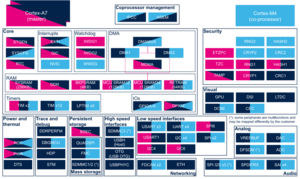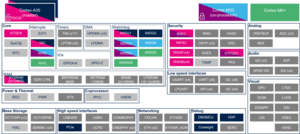Registered User mNo edit summary |
Registered User m (remove "Cortex-A35 master boot" chapter, useless for v6) Tag: 2017 source edit |
||
| (4 intermediate revisions by 2 users not shown) | |||
| Line 1: | Line 1: | ||
{{ApplicableFor | |||
|MPUs list=STM32MP13x, STM32MP15x, STM32MP25x | |MPUs list=STM32MP13x, STM32MP15x, STM32MP21x, STM32MP23x, STM32MP25x | ||
|MPUs checklist=STM32MP13x, STM32MP15x, STM32MP25x | |MPUs checklist=STM32MP13x, STM32MP15x, STM32MP21x, STM32MP23x, STM32MP25x | ||
}} | }} | ||
==Article purpose== | ==Article purpose== | ||
| Line 29: | Line 30: | ||
The FDCAN peripheral is not used at boot time. | The FDCAN peripheral is not used at boot time. | ||
====On {{MicroprocessorDevice | device=2}}==== | ====On {{MicroprocessorDevice | device=21}}==== | ||
{{#lst:STM32MP2_internal_peripherals_assignment_table_template|stm32mp2_a35_boottime}} | |||
<section begin=stm32mp21_a35_boottime /> | |||
| rowspan="2" | Networking | |||
| rowspan="2" | [[FDCAN internal peripheral | FDCAN]] | |||
| FDCAN1 | |||
| | |||
| | |||
| <span title="assignable peripheral but not supported" style="font-size:21px">⬚</span> | |||
| | |||
|- | |||
| FDCAN2 | |||
| | |||
| | |||
| <span title="assignable peripheral but not supported" style="font-size:21px">⬚</span> | |||
| | |||
|- | |||
<section end=stm32mp21_a35_boottime /> | |||
|} | |||
====On {{MicroprocessorDevice | device=23}}==== | |||
{{#lst:STM32MP2_internal_peripherals_assignment_table_template|stm32mp2_a35_boottime}} | |||
<section begin=stm32mp23_a35_boottime /> | |||
| rowspan="2" | Networking | |||
| rowspan="2" | [[FDCAN internal peripheral | FDCAN]] | |||
| FDCAN1 | |||
| | |||
| | |||
| <span title="assignable peripheral but not supported" style="font-size:21px">⬚</span> | |||
| | |||
|- | |||
| FDCAN2 | |||
| | |||
| | |||
| <span title="assignable peripheral but not supported" style="font-size:21px">⬚</span> | |||
| | |||
|- | |||
<section end=stm32mp23_a35_boottime /> | |||
|} | |||
====On {{MicroprocessorDevice | device=25}}==== | |||
{{#lst:STM32MP2_internal_peripherals_assignment_table_template|stm32mp2_a35_boottime}} | {{#lst:STM32MP2_internal_peripherals_assignment_table_template|stm32mp2_a35_boottime}} | ||
<section begin=stm32mp25_a35_boottime /> | <section begin=stm32mp25_a35_boottime /> | ||
| Line 92: | Line 138: | ||
|- | |- | ||
<section end=stm32mp15_runtime /> | <section end=stm32mp15_runtime /> | ||
|} | |||
====On {{MicroprocessorDevice | device=21}}==== | |||
{{#lst:STM32MP2_internal_peripherals_assignment_table_template|stm32mp21_runtime}} | |||
<section begin=stm32mp21_a35_runtime /> | |||
| rowspan="2" | Networking | |||
| rowspan="2" | [[FDCAN internal peripheral | FDCAN]] | |||
| FDCAN1 | |||
| <span title="assignable peripheral but not supported" style="font-size:21px">⬚</span><sup>OP-TEE</sup> | |||
| <span title="assignable peripheral" style="font-size:21px">☐</span> | |||
| <span title="assignable peripheral but not supported" style="font-size:21px">⬚</span> | |||
| <span title="assignable peripheral" style="font-size:21px">☐</span> | |||
| | |||
|- | |||
| FDCAN2 | |||
| <span title="assignable peripheral but not supported" style="font-size:21px">⬚</span><sup>OP-TEE</sup> | |||
| <span title="assignable peripheral" style="font-size:21px">☐</span> | |||
| <span title="assignable peripheral but not supported" style="font-size:21px">⬚</span> | |||
| <span title="assignable peripheral" style="font-size:21px">☐</span> | |||
| | |||
|- | |||
<section end=stm32mp21_a35_runtime /> | |||
|} | |||
====On {{MicroprocessorDevice | device=23}}==== | |||
{{#lst:STM32MP2_internal_peripherals_assignment_table_template|stm32mp23_runtime}} | |||
<section begin=stm32mp23_a35_runtime /> | |||
| rowspan="2" | Networking | |||
| rowspan="2" | [[FDCAN internal peripheral | FDCAN]] | |||
| FDCAN1 | |||
| <span title="assignable peripheral but not supported" style="font-size:21px">⬚</span><sup>OP-TEE</sup> | |||
| <span title="assignable peripheral" style="font-size:21px">☐</span> | |||
| <span title="assignable peripheral but not supported" style="font-size:21px">⬚</span> | |||
| <span title="assignable peripheral" style="font-size:21px">☐</span> | |||
| | |||
|- | |||
| FDCAN2 | |||
| <span title="assignable peripheral but not supported" style="font-size:21px">⬚</span><sup>OP-TEE</sup> | |||
| <span title="assignable peripheral" style="font-size:21px">☐</span> | |||
| <span title="assignable peripheral but not supported" style="font-size:21px">⬚</span> | |||
| <span title="assignable peripheral" style="font-size:21px">☐</span> | |||
| | |||
|- | |||
<section end=stm32mp23_a35_runtime /> | |||
|} | |} | ||
| Line 130: | Line 221: | ||
* '''Linux<sup>®</sup>''': [[Networking_overview|networking overview]] and [[CAN overview|CAN framework]] | * '''Linux<sup>®</sup>''': [[Networking_overview|networking overview]] and [[CAN overview|CAN framework]] | ||
* '''STM32Cube''': [[ | * '''STM32Cube''': [[STM32CubeMP15 Package architecture|FDCAN HAL driver]] and {{CodeSource | STM32CubeMP1 | Drivers/STM32MP1xx_HAL_Driver/Inc/stm32mp1xx_hal_fdcan.h | header file of FDCAN HAL module}} | ||
==How to assign and configure the peripheral== | ==How to assign and configure the peripheral== | ||
Latest revision as of 16:29, 22 October 2024
1. Article purpose[edit | edit source]
The purpose of this article is to:
- briefly introduce the FDCAN peripheral and its main features,
- indicate the peripheral instances assignment at boot time and their assignment at runtime (including whether instances can be allocated to secure contexts),
- list the software frameworks and drivers managing the peripheral,
- explain how to configure the peripheral.
2. Peripheral overview[edit | edit source]
The FDCAN peripheral handles data communication in a Controller Area Network (CAN) bus system using message-based protocol originally designed for in-vehicle communication.
The CAN subsystem consists of several CAN modules (2 for STM32MP1 series and 3 for STM32MP2 series), a shared message RAM and a clock calibration unit.
All FDCAN instances are compliant with classic CAN protocol[1] and CAN FD[2] (CAN with Flexible Data-Rate) protocol.
In addition, the first CAN module FDCAN1 supports time triggered CAN (TTCAN).
All FDCAN modules share a dedicated 10-Kbyte CAN RAM for message transfers.
Refer to the STM32 MPU reference manuals for the complete list of features, and to the software frameworks and drivers, introduced below, to see which features are implemented.
3. Peripheral usage[edit | edit source]
This chapter is applicable in the scope of the OpenSTLinux BSP running on the Arm® Cortex®-A processor(s), and the STM32CubeMPU Package running on the Arm® Cortex®-M processor.
3.1. Boot time assignment[edit | edit source]
3.1.1. On STM32MP1 series[edit | edit source]
The FDCAN peripheral is not used at boot time.
3.1.2. On STM32MP21 unknown microprocessor device[edit | edit source]
Click on ![]() to expand or collapse the legend...
to expand or collapse the legend...
| Domain | Peripheral | Boot time allocation | Comment | |||
|---|---|---|---|---|---|---|
| Instance | Cortex-A35 secure (ROM code) |
Cortex-A35 secure (TF-A BL2) |
Cortex-A35 non-secure (U-Boot) | |||
| Networking | FDCAN | FDCAN1 | ⬚ | |||
| FDCAN2 | ⬚ | |||||
3.1.3. On STM32MP23 unknown microprocessor device[edit | edit source]
Click on ![]() to expand or collapse the legend...
to expand or collapse the legend...
| Domain | Peripheral | Boot time allocation | Comment | |||
|---|---|---|---|---|---|---|
| Instance | Cortex-A35 secure (ROM code) |
Cortex-A35 secure (TF-A BL2) |
Cortex-A35 non-secure (U-Boot) | |||
| Networking | FDCAN | FDCAN1 | ⬚ | |||
| FDCAN2 | ⬚ | |||||
3.1.4. On STM32MP25x lines  [edit | edit source]
[edit | edit source]
Click on ![]() to expand or collapse the legend...
to expand or collapse the legend...
| Domain | Peripheral | Boot time allocation | Comment | |||
|---|---|---|---|---|---|---|
| Instance | Cortex-A35 secure (ROM code) |
Cortex-A35 secure (TF-A BL2) |
Cortex-A35 non-secure (U-Boot) | |||
| Networking | FDCAN | FDCAN1 | ⬚ | |||
| FDCAN2 | ⬚ | |||||
| FDCAN3 | ⬚ | |||||
3.2. Runtime assignment[edit | edit source]
3.2.1. On STM32MP13x lines  [edit | edit source]
[edit | edit source]
Click on ![]() to expand or collapse the legend...
to expand or collapse the legend...
| Domain | Peripheral | Runtime allocation | Comment | ||
|---|---|---|---|---|---|
| Instance | Cortex-A7 secure (OP-TEE) |
Cortex-A7 non-secure (Linux) | |||
| Networking | FDCAN | FDCAN1 | ☐ | ||
| FDCAN2 | ☐ | ||||
3.2.2. On STM32MP15x lines  [edit | edit source]
[edit | edit source]
Click on ![]() to expand or collapse the legend...
to expand or collapse the legend...
| Domain | Peripheral | Runtime allocation | Comment | |||
|---|---|---|---|---|---|---|
| Instance | Cortex-A7 secure (OP-TEE) |
Cortex-A7 non-secure (Linux) |
Cortex-M4 (STM32Cube) | |||
| Networking | FDCAN | FDCAN1 | ☐ | ☐ | Assignment (single choice) | |
| FDCAN2 | ☐ | ☐ | Assignment (single choice) | |||
3.2.3. On STM32MP21 unknown microprocessor device[edit | edit source]
| rowspan="2" | Networking | rowspan="2" | FDCAN | FDCAN1
| ⬚OP-TEE | ☐ | ⬚ | ☐ | |- | FDCAN2
| ⬚OP-TEE | ☐ | ⬚ | ☐ | |-
|}
3.2.4. On STM32MP23 unknown microprocessor device[edit | edit source]
| rowspan="2" | Networking | rowspan="2" | FDCAN | FDCAN1 | ⬚OP-TEE | ☐ | ⬚ | ☐ | |- | FDCAN2 | ⬚OP-TEE | ☐ | ⬚ | ☐ | |-
|}
3.2.5. On STM32MP25x lines  [edit | edit source]
[edit | edit source]
Click on ![]() to expand or collapse the legend...
to expand or collapse the legend...
| Domain | Peripheral | Runtime allocation | Comment | |||||
|---|---|---|---|---|---|---|---|---|
| Instance | Cortex-A35 secure (OP-TEE / TF-A BL31) |
Cortex-A35 non-secure (Linux) |
Cortex-M33 secure (TF-M) |
Cortex-M33 non-secure (STM32Cube) |
Cortex-M0+ (STM32Cube) | |||
| Networking | FDCAN | FDCAN1 | ⬚OP-TEE | ☐ | ⬚ | ☐ | ||
| FDCAN2 | ⬚OP-TEE | ☐ | ⬚ | ☐ | ||||
| FDCAN3 | ⬚OP-TEE | ☐ | ⬚ | ☐ | ||||
4. Software frameworks and drivers[edit | edit source]
Below are listed the software frameworks and drivers managing the FDCAN peripheral for the embedded software components listed in the above tables.
- Linux®: networking overview and CAN framework
- STM32Cube: FDCAN HAL driver and header file of FDCAN HAL module
5. How to assign and configure the peripheral[edit | edit source]
The peripheral assignment can be done via the STM32CubeMX graphical tool (and manually completed if needed).
This tool also helps to configure the peripheral:
- partial device trees (pin control and clock tree) generation for the OpenSTLinux software components,
- HAL initialization code generation for the STM32CubeMPU Package.
The configuration is applied by the firmware running in the context in which the peripheral is assigned.
When the FDCAN peripheral is assigned to the Linux® OS, it is configured through the device tree according to the information given in the FDCAN device tree configuration article.
6. References[edit | edit source]
- ↑ CAN protocol implementations, from the CAN in Automation group (CiA)
- ↑ CAN FD - The basic idea, from the CAN in Automation group (CiA)


